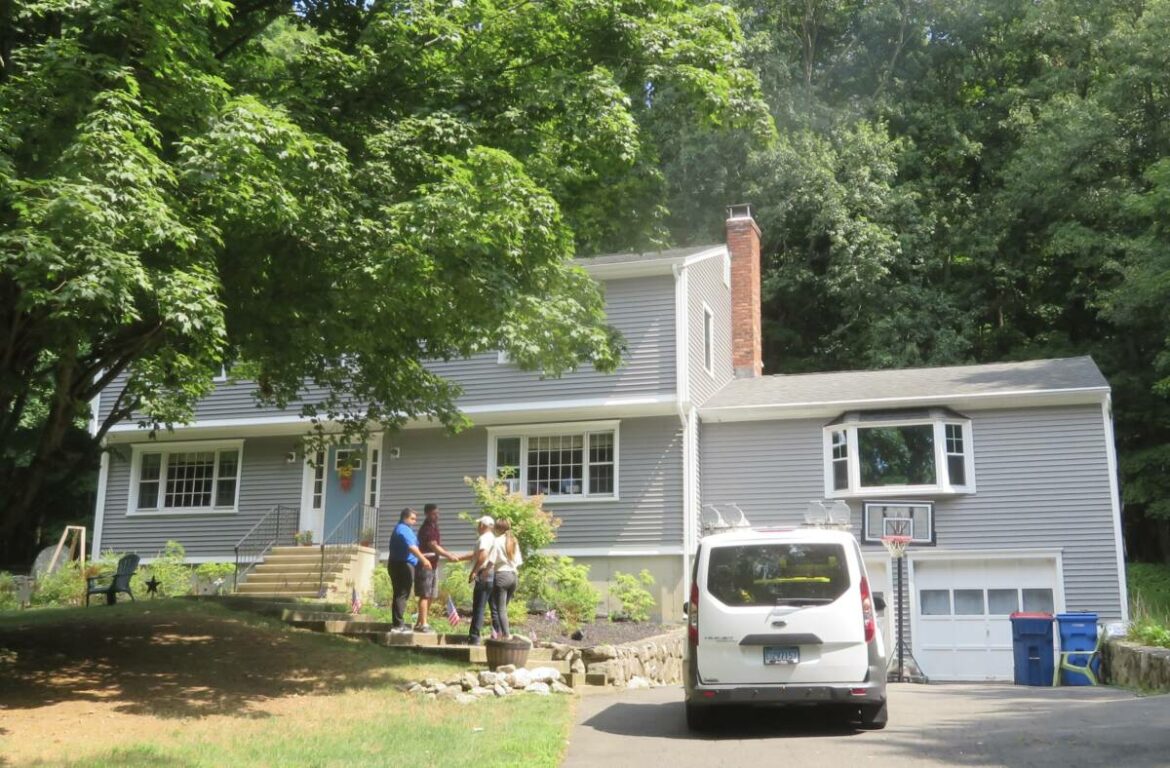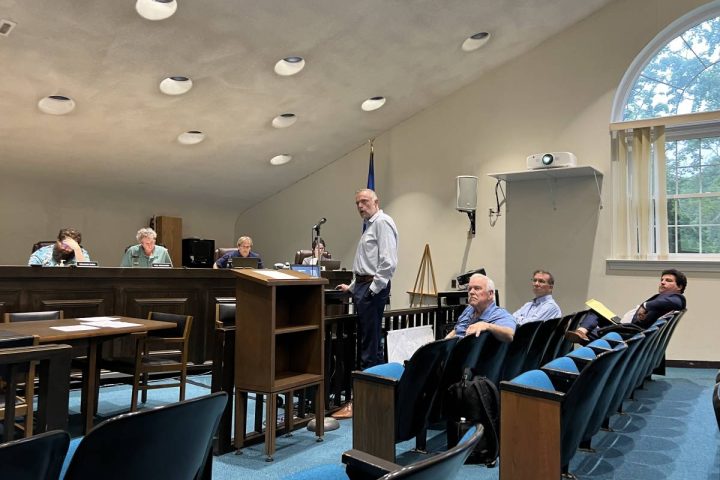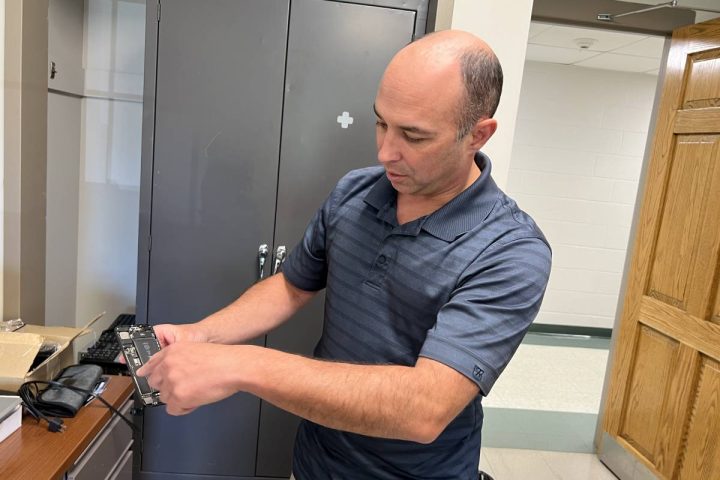MONROE, CT — Ronni Bedoya, the lead technician of Home Doctor of America, used a flashlight to examine ducts for gaps in the basement of Michael and Lisa Lambert’s colonial on Misty Lane Monday morning, and Bedoya later climbed a ladder to check insulation in the attic.
To measure the air tightness of the house, Bedoya and his fellow techs closed all of the windows and set up a large fan in front of the back door for a blower door test, identifying leaks that could reduce heating and cooling efficiency of the home.

The Lamberts, who have three children, took advantage of the Home Energy Solutions program, in which an authorized contractor does a home energy audit for a $50 copay.
“I finally convinced my wife to go solar to get off Eversource,” Michael Lambert said of plans to reduce his electricity bills. “The solar company let us know about the program, so we decided to get the assessment.”
Alexandra Sopelak, a supervisor of energy efficiency at Eversource Energy, said homeowners installing a solar energy system are required to participate in the Home Energy Solutions program to ensure the right size panels and system is chosen for their needs.
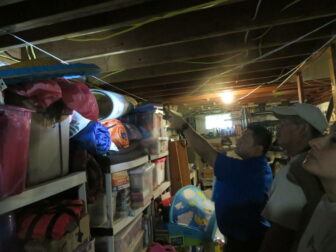
Aside from solar customers, many homeowners participate in Home Energy Solutions simply to improve energy efficiency in their homes and identify upgrades beyond the home visit.
“This is our most popular program by far,” Sopelak, said of HES.
Home Energy Solutions is available through Eversource and United Illuminating. It is one of a variety of programs under the Energize Connecticut state initiative. So far this year, about 10,000 of Eversource’s residential customers have participated in the program and more than 16,000 took advantage of it in 2021, according to Sopelak.
For information and to sign up, click on this link.
“A small fraction of everyone’s electric and natural gas bills pay for the program through the Combined Public Benefits Charge on the bill,” Sopelak said, adding the money goes into the state’s Conservation and Load Management Fund.
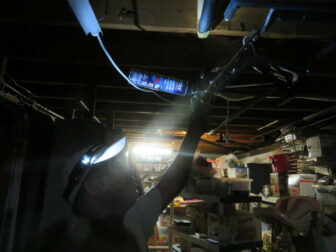
Eversource and United Illuminating put together a budget for residential programs and the state ensures the money is spent on projects geared to Connecticut’s energy goals.
“I think it’s important to know there is a plan of how to use what comes out of your bill for this fund, so the state can reduce its impact on the environment,” Sopelak said.
Though Lambert is going solar, Sopelak said homes with solar systems are still on the grid, because the panels do not produce energy all the time. She said solar customers save money by reducing the number of kilowatt hours their home uses.
The Lamberts’ home visit
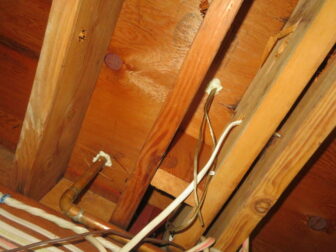
Through the HES program, homeowners receive a visit from an authorized contractor who provides approximately $1,000 worth of diagnostic and energy savings services for a $50 co-pay. The visit includes blower door and duct tests to identify significant air leaks, and professional sealing to improve energy efficiency.
During the visit, the technician also installs low flow faucets and shower heads and homeowners receive a personalized booklet with recommendations for upgrades, such as insulation and heating, cooling and water heating equipment.
Homeowners are eligible for rebates for some of these upgrades.
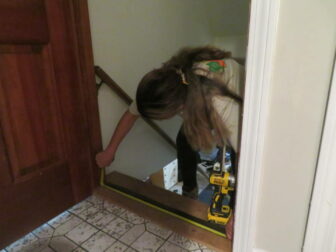
On Monday afternoon, a white Home Doctor of America van was parked in the Lamberts’ driveway.
Ronni Bedoya, the lead technician with Home Doctor of America, an approved contractor in the HES program, arrived with tech, Juan Najera, and Jazmin Taborda, a tech in training.
Bedoya held a clipboard, while standing on the front walkway, as he spoke to Michael Lambert, explaining all of the work they were going to do.
“We’ll check your basement and attic to make sure there is no asbestos,” Bedoya said, adding of the blower door test, “if windows are drafty, it will show us where that draft is coming from.”
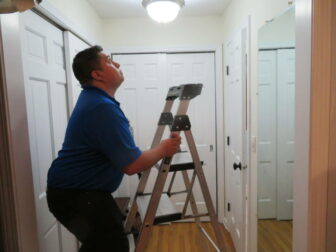
Lambert opened a garage door and led everyone inside, where they accessed the basement.
Bedoya shined a flashlight up into the ducts, looking for any gaps around wires and pipes, as well as any asbestos or mold.
Later that afternoon, Najera caulked gaps that were found and Taborda crouched down at the top of the stairs with measuring tape and a drill to install weather stripping under a door to the first floor.
“We’ll test the heating system and hot water tank,” Bedoya told Lambert. “Can we check your attic now? Will we need a ladder?”
The Home Doctor techs did need a ladder and Bedoya had one in the work van.
The blower door test
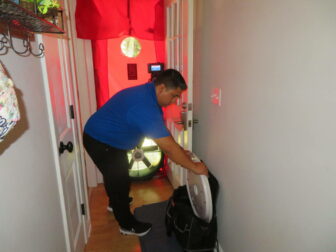
The Home Doctor of America crew made sure all of the windows were closed while preparing for the blower door test.
A giant fan was brought in and set up by the back door of the home. During the test, the fan brings air in from outside to measure how many cubic feet per minute (CFM) flows through the house. Bedoya said one CFM is the equivalent of the air in a basketball.
Bedoya held a tablet, which displayed readings. He said the air tightness number is calculated using the square footage and number of people living in a house.
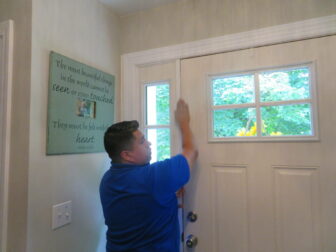
If the CFM reading is below the number, Bedoya said to do nothing, “because you want to give your house room to breathe or it creates moisture and mold in the home.”
For example, if the tablet says the number is 2,500 and the blower door reading is 2,300, Bedoya said your house is too air tight and you will have to turn on fans to shower and cook and open windows at times to let the house breathe.
If the reading is over 3,500, Bedoya said too much air is going through and you have to seal where you can to bring that number down.
‘Upgrading as we go’
The Lamberts’ four-bedroom colonial was built in 1977, and the couple bought it five years ago. Since then, Michael Lambert said they have been making upgrades as they go.
His father-in-law owns a home improvement company and already replaced “about half” of the windows. He also put in insulation board and sided over it in 2019, according to Lambert.
Lambert said he hopes to install solar panels this year to cut down on electricity costs.
“The next step is to have a more efficient house and getting things up to speed, to bring it into the 21st Century as opposed to the 1970s,” he said.
For related articles, visit The Sun’s Home section.

